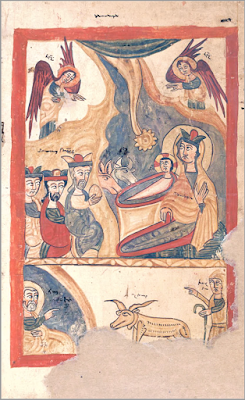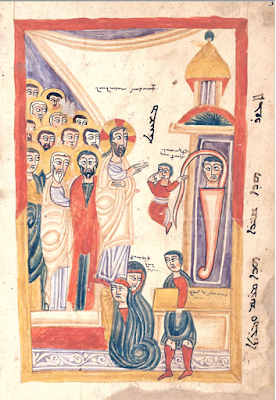the East. I've been working to get this blog back up, and while I have several entries in development, this is the topic I get asked about most often.
In the Bibliothèque nationale de France there is a set of 10 folios taken out of a gospel manuscript by the great Syriac scholar and martyr Mar Addaï Scher, who donated these manuscript pages to that library in 1909. Bibliothèque nationale MS Syr 344. Here is my loose translation of the French description, which you can read as well as look at the manuscript by clicking here. From that link:
Title: Volume of paintings illustrating the life of Jesus together with inscriptions in Syriac and in Armenian.
Publication date: 1501-1600However, when I first looked at the icons, I thought I detected three distinct scribal hands in the inscriptions: one rather old writing in India ink; another latter hand using gall ink; and the Armenian hand, which also looked rather latter than the Syriac hand using India ink. I am no expert Syriac paleographer, so I recently showed them to His Grace Mar Awa, Bishop of Modesto and California, and he placed the India ink hand sometime around the twelfth century, which was my instinct. I recall His Grace making particular mention of how the letter mim is written here; I will certainly get him to take a closer look. These icons seem to be taken from an earlier manuscript (around 12th century) and then added to the Mosul Gospel. The different handwriting suggests that different readers added inscriptions over time. Even the oldest handwriting does not seem to quite fit in with the carefully laid-out iconography but almost seems scribbled into the images, so even this perhaps 12th century hand may be latter than the icons.
Format: Paper: thick, dark beige with horizontal undulations and many faint horizontal lines formed when the hand laid paper was drying on a wire grid (vergeures). 10 folia. Measures 312 x 198 mm (12¼ x 7¾ inches).
Description: According to Leroy, this manuscript is a quire of illustrations taken from the Gospel book preserved in Syriac manuscript 15 of the Chaldean Patriarchate in Mosul, Iraq. The eighteen paintings it contains would have been originally attached to the end of the Mosul manuscript. If it can be proved that this quire of illustrations originally belonged to the Mosul Gospel [and so were written contemporaneously with that manuscript], then this manuscript would date, together with the Mosul Gospel, to AD 1497 (1806 of the Greeks) and would have been written by Abraham the Son of Dodo in the village of ܥܘܪܩ of the Diocese of Séert during the reign of Patriarch Mar Shimun and of Mar Yuḥannan, bishop of Athel.
Whether from the twelfth or the fifteenth century, this is my favorite icon trove of the Assyrian Church of the East. At first I was going to put my PDF of the icons here, but I think it will be nice to post them and discuss them individually.

The first folio has this icon of the Annunciation (Folio 1v), which we celebrate this upcoming Sunday. Maybe one of you can translate the Armenian? To the right of the descending dove and continuing above Mary is written: "This is the Holy Spirit that descends (feminine participle) upon Mary." Next to the archangel: "Gabriel." The archangel Gabriel is making an interesting hand gesture, almost like a Byzantine priestly blessing, but more likely the older form of the Church of the East blessing with two fingers (like Russian Old Believers). The architectural setup on all of these icons is remarkable as you'll notice the iconographer using geometry in a combination of both rigid elements like the pillars and arches, but then violating those barriers, such as the Holy Spirit does here as it penetrates the ceiling to reach Mary's womb.

The next icon is of the Nativity of Christ (2r), and it does not have any Syriac inscription, which might suggest that all the inscriptions were by a different person than the iconographer. The Nativity icon is also the most busy, so maybe there was not as much convenient space to jot down some captions on the icons, which is what all the inscriptions look like to me. Again, there is that dynamic of the cave with the Virgin and Child together with the Three Magi being very immobile, but the movement of the Spirit placing the star within the cave as well as the angels making the same blessing gesture.
I think the lower scene comes from the Protoevangelium of James, where Joseph is walking while trying to find a midwife for Mary, who is about to be delivered of child:
And [Joseph] found a cave there, and led her into it; and leaving his two sons beside her, he went out to seek a midwife in the district of Bethlehem. And I Joseph was walking, and was not walking; and I looked up into the sky, and saw the sky astonished; and I looked up to the pole of the heavens, and saw it standing, and the birds of the air keeping still. And I looked down upon the earth, and saw a trough lying, and work-people reclining: and their hands were in the trough. And those that were eating did not eat, and those that were rising did not carry it up, and those that were conveying anything to their mouths did not convey it; but the faces of all were looking upwards. And I saw the sheep walking, and the sheep stood still; and the shepherd raised his hand to strike them, and his hand remained up. And I looked upon the current of the river, and I saw the mouths of the kids resting on the water and not drinking, and all things in a moment were driven from their course. (Protoevangelium of James, 18)
 Next is an icon of the Presentation of Christ in the Temple (2v), which is celebrated on the Second Sunday after the Nativity in the Assyrian Church. Saint Simeon, above whom is written "Simeon the Aged," is holding the divine child. Behind Saint Simeon is Saint Anna, daughter of Phanuel. Opposite St Simeon and Christ is St Joseph with "a pair of turtle doves or two young pigeons." (Luke 2.24) Interestingly, it looks like Simeon receives Christ from the Blessed Virgin over an empty altar, which would allude to Christ as the manna from on high replacing the shew bread. If my reading is true, then Christ is shown as the true presence of God whose very presence makes his metaphor extraneous. The temple is a three domed Church, with crosses upon each dome since, in icons, we see the divine truth revealed rather than just the historical dimension of what happened. Of course, one must not forget the presence of onion domes in this, and following, icons from this manuscript, which predates that architectural feature showing up in Russia. Perhaps these icons reveal something of the architectural heritage of Assyrians, which was lost due to Islamic prohibition and demolition of our ancient domes. Either way, the onion domes are a really neat feature.
Next is an icon of the Presentation of Christ in the Temple (2v), which is celebrated on the Second Sunday after the Nativity in the Assyrian Church. Saint Simeon, above whom is written "Simeon the Aged," is holding the divine child. Behind Saint Simeon is Saint Anna, daughter of Phanuel. Opposite St Simeon and Christ is St Joseph with "a pair of turtle doves or two young pigeons." (Luke 2.24) Interestingly, it looks like Simeon receives Christ from the Blessed Virgin over an empty altar, which would allude to Christ as the manna from on high replacing the shew bread. If my reading is true, then Christ is shown as the true presence of God whose very presence makes his metaphor extraneous. The temple is a three domed Church, with crosses upon each dome since, in icons, we see the divine truth revealed rather than just the historical dimension of what happened. Of course, one must not forget the presence of onion domes in this, and following, icons from this manuscript, which predates that architectural feature showing up in Russia. Perhaps these icons reveal something of the architectural heritage of Assyrians, which was lost due to Islamic prohibition and demolition of our ancient domes. Either way, the onion domes are a really neat feature.The icon of the Raising of Lazarus (3r) has all twelve disciples together with Christ as Mary and Martha weep at His feet while he blesses with two fingers extended, perhaps with the lower finger partially extended as well (?). Lazarus's soul looks at Christ as it is being called back to his body, with stray bit of shrouding making a connection between the soul and body of the deceased. Below him is the attendant carrying the door of the tomb. The Syriac inscription in the middle says "Christ," while the one outside the frame (from top to bottom) says "Lazarus...this is the tomb...this is Mary and Martha." The divine purple unites the apostles, Christ (his garment is purple as well) and the death-space of Lazarus. Interestingly, the halo of Christ is marked by three red arms of a cross rather than the inscription more typical of Byzantine icons. Generally, these icons seem Byzantine until looking closely and noticing remarkably original elements that mark a separate tradition. I am fairly sure that the iconography purposefully violates the frames of his icons as do the red boots of the attendant here.
As its Syriac inscription says, this is the "Sunday of Hosannas," or Palm Sunday (3v). This time the architectural element is a simple onion domed Jerusalem city wall, with the adults within the wall and a child laying down clothes at the feet of Christ. The Twelve are behind Christ as he rides into Jerusalem. The crowd seems a bit sinister as they hold up their hosanna branches, with the two peering on from above. The stylized palm tree frames a division between Christ and the city. Another onion dome breaks the frame above as does the kneeling and reverent child below.

Finally for this installment of MS 344, the Baptism of Christ by John in the River Jordan (3bis r) has the vertical Syriac inscription "John...Christ...in the Jordan," and the out-of-frame "angel." Christ is in the middle of the river as John baptizes him, though it is Christ's right hand that is blessing. The angel serves as Christ's deacon, holding a receiving cloth, though it is red for Christ is God. The hand of God, again with a two fingered blessing, sends down the Holy Spirit, which here is looking upward. Perhaps it is an intentional representation of the trinity in that the Spirit is not upside down (or descending) to form a vertical Trinity with God the Father (the commanding hand of blessing) and God the Son.
I have twelve more icons to enjoy writing about, and they will be up soon, six at a time. Please do "follow by email" by putting in your email address in the box on the upper right. If you have some insight or observations on these icons, please share in the comments.



Are there Assyrian iconographers today? If not, do you use other icons in churches?
ReplyDelete